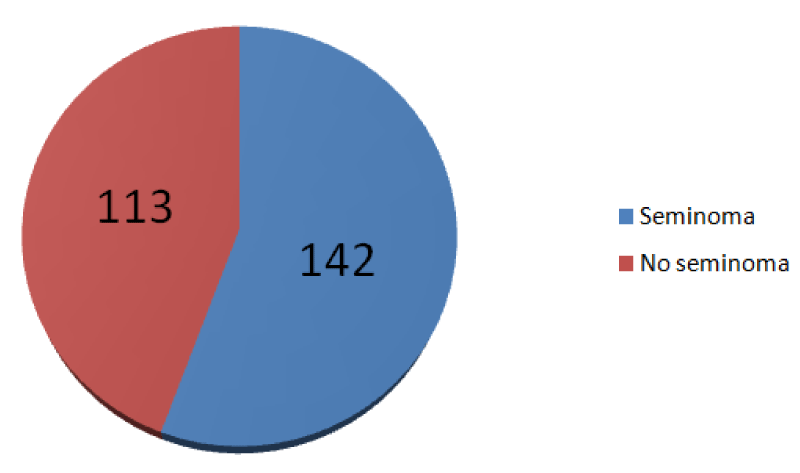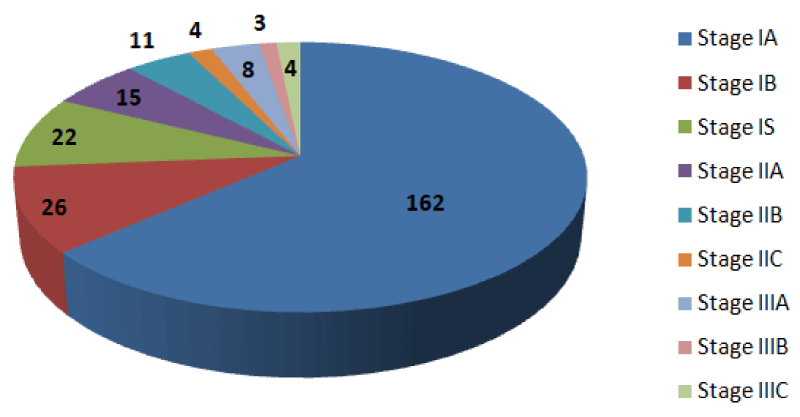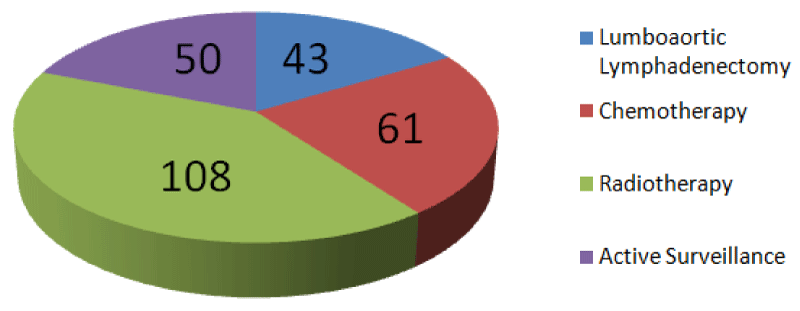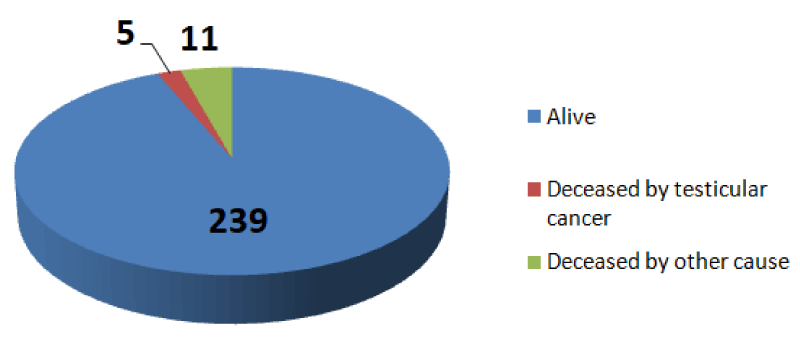Archive of Urological Research
Testicular Cancer Mortality in Chile: Is it as high as we think? 41 years of experience in a single center
Nicolás Pieressa P1*, José Rojas C1, Carolina Bonomo M1, José Villena H1, Ítalo Raineri V2, Sebastián Oporto U2, Cristián Alliende2, Miguél Sarrás J3, Christopher Horn B3, Bruno Vivaldi J3, Iván Saez V3, Felipe Mandujano T3 and Fernando Coz3,4
2Urology Resident, Faculty of Medicine, University of the Andes, Santiago, Chile
3Urologist, Santiago Military Hospital, University of the Andes, Santiago, Chile
4Department of Urology, University of the Andes, Santiago, Chile
Cite this as
Nicolás Pieressa P, José Rojas C, Carolina Bonomo M, José Villena H, Ítalo Raineri V, et al. (2019) Testicular Cancer Mortality in Chile: Is it as high as we think? 41 years of experience in a single center. Arch Urol Res 3(1): 009-011. DOI: 10.17352/aur.000006Introduction: Testicular cancer carries a good prognosis, with survival rates over 70% at any stage. According to the GLOBOCAN database, Chile has the highest mortality rate worldwide, without a clear explanation of why this is the case. The objective of this study is to contrast the observed deaths in a chilean center during a 41-year period, to the national data previously reported by GLOBOCAN.
Methods: For this retrospective descriptive study, data was retrieved from medical records from every patient diagnosed with testicular cancer between the years 1978-2019 in our center, and their death certificates were assessed for comparison. Histological type, staging, adjuvant treatment, and cause of death, among other variables, were analyzed.
Results: Out of 255 patients diagnosed with testicular cancer, 239(93.7%) were alive at the time of data collection. Out of the 16 recorded deaths, 5(2%) had testicular cancer as cause of death, two out of these five patients had early stage cancers, completed 5 years follow-up without relapse, had multiple comorbidities, and had unspecific information in the death certificate. Thus, testicular cancer cannot be attributed with certainty as the cause of death in those patients.
Conclusion: Chile has the highest mortality rate for testicular cancer worldwide. In our center 40% of the patients that have testicular cancer as cause of death had presumably been incorrectly registered in the death certificate. A possible explanation for the high mortality in Chile could be an incorrect registration of testicular cancer as cause of death.
Introduction
Testicular cancer is generally known as a good prognosis malignancy, with survival rates higher than 70%, even in advanced stages [1-3]. Despite of this, Chile is the country with the highest mortality rate in the world according to the Globocan database [4].
According to the Department of Statistics and Information of the Ministry of Health of Chile (DEIS), testicular cancer deaths averaged 94 deaths per year between the years 2003-2007 [5] and during that same time period the Chilean Cancer Poblational Registry reported 7.8 new cases for every 100.000 men per year [6]. According to the National Institute of Statistics, between the years 2003 and 2007, there was an average of 8,053,734 men [7], which correlates to an estimate of 628 cases per year in average during that time period. With the incidence reported by GLOBOCAN and the results of the 2017 census, we can estimate for the year 2018 an approximate of 817 new cases of testicular cancer [4].
These numbers surprise us, given that the experience of the urologists in the Military Hospital of Santiago is that patients rarely deceased due to a testicular cancer.
Also, in Chile testicular cancer treatment is completely covered by the public healthcare system and every patient in the country has access to treatment in a timely manner [8,9]. The veracity of its high mortality rate has remained unexplored and rises questions.
The objective of the present study is to expose the mortality of testicular cancer in a chilean center during a 41 year period, and compare it to what is described at the national level.
Materials and Methods
We developed a quantitative, descriptive and retrospective study. Medical records, both in paper and electronic formats, and follow-up protocols of every patient diagnosed with testicular cancer between the years 1978-2019 at the Military Hospital of Santiago were revised.
Death certificates were solicited from the webpage of the Civil Registry (which keeps track of every birth, death and registration in the country) [10] and only those of patients who had effectively deceased between the years 1978-2019 were emitted. This was done to identify all of the patients that had died because of testicular cancer even if they were lost in follow-up in our center. Data was collected until June 2019, meaning only deaths until that date were registered.
Several variables were registered: Histological type (which were later grouped in seminoma/non seminoma), cancer stage, treatment received, status at the time of data collection (alive/deceased), and cause of death if the patient had died.
Special emphasis was given to those patients that had testicular cancer as cause of death in their death certificates, to analyze the characteristics of these patients and confirm if this was effectively their cause of death.
Results
Two hundred and fifty-five (255) patients were diagnosed and treated for testicular cancer in the Military Hospital of Santiago during the years 1978-2019. Out of these, 142(55.7%) were seminomas, while 113(44.3%) were non-seminomas (Figure 1).
In terms of staging, at the time of diagnosis and treatment 162(63%) were in stage IA, 26(10.1%) in stage IB, 22(8.6%) in IS, 15(5.8%) in IIA, 11(4.3%) in IIB, 4(1.5%) in IIC, 8(3%) in IIIA, 3(1.1%) in IIIB, and 4(1.5%) in IIIC (Figure 2).
Every patient underwent radical inguinal orchiectomy, and then as adjuvant therapy 43(16.8%) underwent retroperitoneal lymph node dissection (RPLND), 61(23.9%) received Chemotherapy (QT), 108(42.3%) received Radiotherapy (RT) and 50(19.6%) underwent active surveillance (Figure 3).
Out of the 255 patients, 239(93.7%) were alive until June 2019. Out of the 16 deceased patients, only 5(2%) had testicular cancer written as the cause of death in their death certificate, while 11(4.3%) would have died by another cause (Figure 4).
After extensive revision of the medical records of those patients that had testicular cancer registered as cause of death, it is notable that 2 out of the 5 patients (40%), that had been diagnosed with seminoma and embryonal carcinoma, and that were treated with QT and RT+RPLND respectively, were in stages IA and IIA and were followed for at least 5 years after diagnosis with tumor markers and imaging, without evidence of progression or relapse. Both patients died approximately 20 years after the diagnosis, had multiple comorbidities (uncontrolled type 2 diabetes, previous myocardial infarctions, and neurosurgery because of a severe traumatic brain injury in one of the 2 patients). Death certificates for one of the patients described “Cardiorespiratory failure/metastatic testicular cancer”, while the other one described “Acute respiratory failure/metastatic testicular cancer”, without giving any more details, and without any evidence of metastasis in imaging or the medical record.
In contrast, the other 3 patients were in more advanced stages (two in IIIC and one in IIB), some with multiple relapses, and with adverse effects of treatment.
Discussion
Out of the information obtained, there is one major finding that is worth noting, which is that 40% of patients that were registered with testicular cancer as cause of death had unspecific information in their death certificates, didn’t have any evidence of relapse or disease progression in their medical record, and didn’t have the conditions of a patient that would usually die from testicular cancer (they were diagnosed in early stages, without metastasis at the time of diagnosis and follow-up) and they were bearers of multiple comorbidities.
This information makes us suspect that those patients could have actually died because of another reason that was not studied post-mortem, and testicular cancer was attributed as cause of death because the real cause was unknown.
This finding is important because it is possible that a major contribution to the high mortality in Chile is the erroneous registration of causes of death. Almost half of patients apparently deceased because of testicular cancer most probably had their cause of death wrongly attributed to this disease.
Conclusion
Even though Chile has the highest mortality rate for testicular cancer in the world, in our 41-year long series, almost half of the patients that had testicular cancer as cause of death had presumably been incorrectly registered in the death certificate. A possible explanation for having approximately 100 deaths per year according to the GLOBOCAN database and the chilean Ministry of Health, in circumstances where 800 cases are diagnosed per year according to estimations made with testicular cancer incidence and chilean population in the year 2018, is having an erroneous labelling of testicular cancer as cause of death.
We invite chilean urologists to analyze the medical records of their own centers for those patients that have decreased due to testicular cancer. We also suggest to the national doctors to be more careful when writing a death certificate, to avoid generating statistics that could lead to erroneous public health decisions.
- Echaurren E, Baquedano P, Leyton R, Cuevas MA, Gorena M, et al. (2015) Manual de Urología. Sociedad Chilena de Urología 226-250.
- Colette L, Sylvester RJ, Stenning SP, Fossa SD, Mead GM, et al. (1999) Impact of the Treating Institution on Survival of Patients With "Poor-Prognosis" Metastatic Nonseminoma. European Organization for Research and Treatment of Cancer Genito-Urinary Tract Cancer Collaborative Group and the Medical Research Council Testicular Cancer Working Party. J Natl Cancer Inst 91: 839-846. Link: http://bit.ly/36pii4m
- Laguna MP, Albers P, Albrecht W, Algaba F, Bokemeyer C, et al. (2019) Testicular cancer guidelines. European Association of Urology. Presented at the EAU Annual Congress Barcelona.
- World Health Organization (2018) Global Cancer Observatory.
- Deis Minsal (2016) Mortalidad Por Causa, Mortalidad por Tumores Malignos, Cáncer Testicular.
- Vallebuona C Estimación de incidencia de cáncer para Chile 2003-2007. Registro poblacional de Cáncer de Chile 2003-2007. Ministerio de Salud.
- Instituto Nacional de Estadísticas. Registros "Demografía y Vitales" de Chile.
- AUGE. Garantías Explícitas de Salud. Ministerio de Salud de Chile.
- Guía Clínica (2010) Cáncer de Testículo en personas de 15 años y más. Ministerio de Salud 6-31. Link: http://bit.ly/35g2P6n
- Servicio de Registro Civil de Chile. Certificados de defunción.
Article Alerts
Subscribe to our articles alerts and stay tuned.
 This work is licensed under a Creative Commons Attribution 4.0 International License.
This work is licensed under a Creative Commons Attribution 4.0 International License.





 Save to Mendeley
Save to Mendeley
